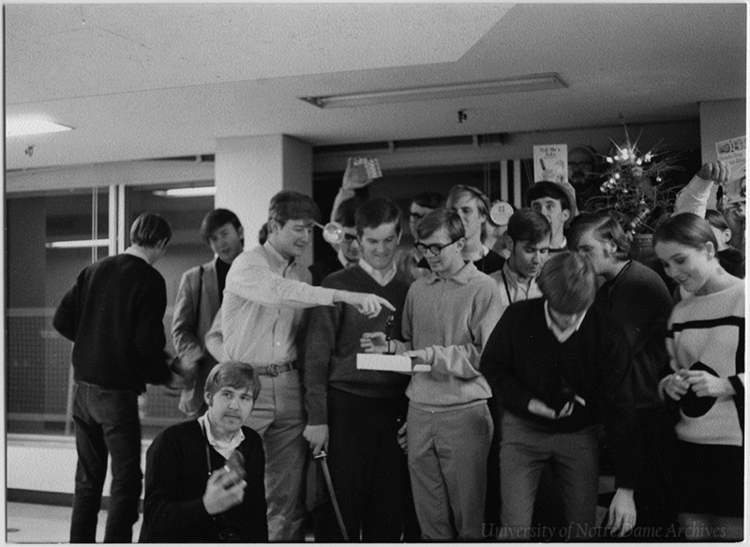 Photos courtesy of the University of Notre Dame Archives
Photos courtesy of the University of Notre Dame Archives
On December 17, 1968, a small group of Notre Dame and St. Mary’s students studying abroad in Tokyo, Japan, gathered in an empty room to have a modest Christmas celebration. Not considered a national holiday, Christmas is observed quite differently in Japan than it is in the United States. Notre Dame students could enjoy a light display in a public square, make plans for a romantic date on Christmas Eve, or look forward to the upcoming ceremonies for the Emperor’s Birthday, but those longing for the familiar exchanging of gifts and hanging of tinsel were required to improvise.
The Sophomore Year Abroad program at Sophia University, established in 1967, was only one year old. Father Hesburgh had initiated two successful programs in Innsbruck, Austria, and Angers, France, but students living in Tokyo faced a set of challenges unique from their European counterparts. As only the second group to spend a year abroad in the Far East, the students lacked a strong network and support system. Programs in Innsbruck and Angers were supervised by well-known Notre Dame professors, but the Japan program was supervised by faculty from the host institution. Tokyo students were expected to navigate an unfamiliar and densely populated metropolis with limited ability to communicate in the local language and limited support from home — all while one year younger than Notre Dame’s average study abroad participant today, and overseas for double the time.
The photos taken at the 1968 Christmas party, donated to the University Archives by former student Paul Roberts, bear witness to the students’ impressive ability to adapt to a culture radically different from their own. The students made do with the resources they had to create a festive atmosphere, decorating their space with a toy reindeer and a sparse tree strung with lights. They exchanged small toys amongst themselves and wore traditional Happi coats, blending together Japanese and American traditions and serving as a microcosm of administrator and student goals for the fledgling international-study program.
- From the Archives
- Fr. Sorin's Eyeglasses
- Irish Brigade Flag
- Flannery O'Connor at ND
- Main Building Steps
- Corby Hall
- Shakespeare Script
- Thanksgiving
- Christmas in Japan
Dr. Thomas E. Stewart, Vice-President for Academic Affairs, envisioned that students who studied abroad would be able to offer insight into world issues, providing stimulating intellectual conversation and cultivating a “cosmopolitan atmosphere” on campus. Likewise, Tokyo program participant Henry Ring, according to the 1968 Dome, hoped to gain a global perspective and exposure to sophisticated ways of thinking. In the yearbook, he explained his desire to “better understand the United States’ involvement in the conflict in Southeast Asia by observing. . .and listening to the views of the Japanese students, which could shed a new light on the situation.”
Today, nearly three in four Notre Dame students will partake in a study abroad program before they graduate, ranking the University second in the nation for study abroad participation. Conditions in Asia have improved significantly for Domers abroad since the days of this lonely Christmas celebration — Notre Dame now operates five study abroad programs in Japan; a Global Gateway in Beijing, China; and global centers in Mumbai and Hong Kong.
From the Archives is written by the staff of the University of Notre Dame Archives highlighting notable pieces from their collection. Through its rich historical resources, the University Archives provides campus, national and international communities with a broad historical focus on the evolution of the University of Notre Dame, its contributions to higher education, and its place in history.